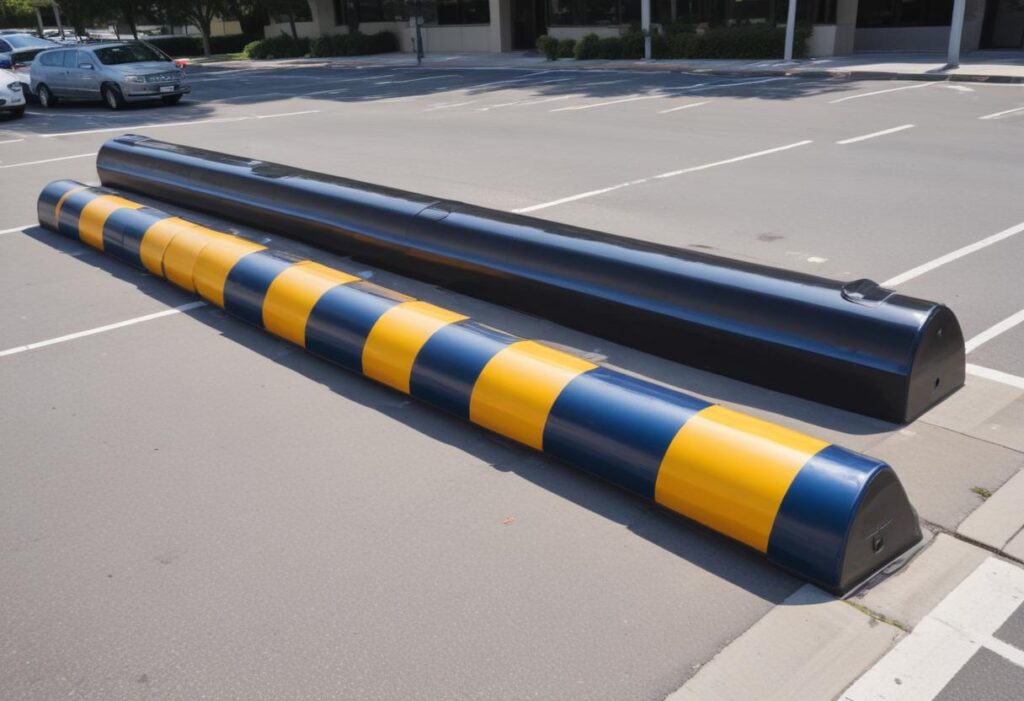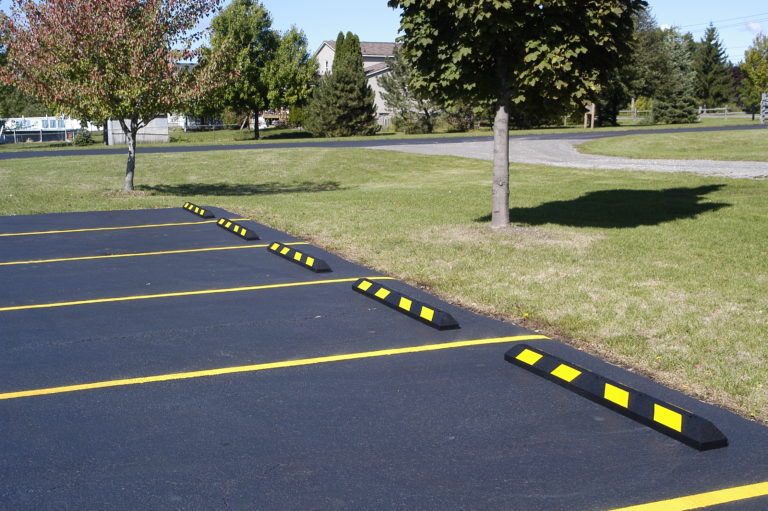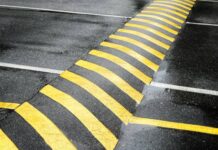How Parking Bumpers Enhance Safety and Protect Your Property: Key Benefits Explained
Parking bumpers, often seen in commercial and residential parking lots, serve more purposes than merely marking parking spaces. They play a crucial role in enhancing safety and protecting property, which ultimately contributes to a better experience for both business owners and customers. In this blog, we will explore the various ways in which parking bumpers enhance safety and protect your property, detailing their key benefits and offering insights into why investing in them can be a smart decision.
If you’re looking for professional advice or services related to parking bumpers, contact Commonwealth Paving at 136 Outerloop, Louisville, Kentucky 40214, or call us at +1 502 459 7283. Our experts are here to help you implement effective solutions for your parking lot needs.
1. Understanding the Role of Parking Bumpers
Parking bumpers, also known as parking blocks, wheel stops, or curb stops, are physical barriers placed at the end of parking spaces to prevent vehicles from overextending into other areas. They are typically made of concrete, rubber, or plastic, and come in various shapes and sizes depending on their intended use.
Key Functions of Parking Bumpers:
- Space Management: They help define parking spaces clearly, ensuring that vehicles stay within designated areas.
- Safety Barrier: They act as a barrier to protect pedestrians and property from vehicle encroachment.
- Guidance: They provide visual and physical cues to drivers, helping them park correctly and avoid collisions.
Understanding these functions helps highlight the importance of parking bumpers in maintaining an orderly and safe parking environment.
2. Enhancing Safety for Drivers and Pedestrians
One of the primary benefits of parking bumpers is their role in enhancing safety. They prevent vehicles from encroaching on pedestrian pathways, landscaping, or other parked vehicles, reducing the risk of accidents and property damage.
How Parking Bumpers Improve Safety:
- Protect Pedestrian Areas: By preventing vehicles from overextending into sidewalks or walkways, parking bumpers ensure that pedestrians can move safely through the parking lot without the risk of being hit by a vehicle.
- Prevent Collisions: They act as a buffer between parked vehicles and obstacles such as walls, curbs, or other vehicles, reducing the likelihood of accidental collisions.
- Clear Marking of Boundaries: They clearly mark the end of parking spaces, helping drivers to park within designated areas and avoid accidental damage to nearby structures or vehicles.
By enhancing safety through the strategic placement of parking bumpers, you contribute to a more secure environment for both drivers and pedestrians.

3. Protecting Property and Landscaping
Parking bumpers are not only beneficial for safety but also play a crucial role in protecting property and landscaping from damage caused by vehicles. They act as a physical barrier that prevents vehicles from encroaching on valuable property areas.
Property and Landscaping Protection:
- Preserve Landscaping: Placing parking bumpers around landscaped areas helps protect plants, shrubs, and trees from being damaged by vehicle tires, which can cause soil erosion and plant destruction.
- Prevent Damage to Structures: They prevent vehicles from hitting curbs, walls, or building foundations, reducing the risk of structural damage and repair costs.
- Maintain Cleanliness: By preventing vehicles from driving over landscaped areas, parking bumpers help keep your property clean and well-maintained.
Investing in parking bumpers is an effective way to safeguard your property and landscaping from potential damage caused by everyday vehicle traffic.
4. Reducing Repair and Maintenance Costs
Regular repair and maintenance of parking lots can be costly, especially if vehicles frequently cause damage to the pavement, landscaping, or other property features. Parking bumpers can help reduce these costs by preventing common types of damage.
Cost Benefits of Parking Bumpers:
- Minimize Pavement Damage: By acting as a barrier between vehicles and the edge of parking spaces, parking bumpers reduce the risk of cracks, potholes, and other forms of pavement damage.
- Lower Repair Costs: With fewer incidents of vehicle-related damage, the need for costly repairs and maintenance is minimized, leading to long-term savings.
- Extend Property Life: Protecting both the pavement and landscaping from vehicle damage can extend the overall lifespan of your property features, reducing the frequency of major repairs or replacements.
By investing in parking bumpers, you can enjoy substantial savings on repair and maintenance costs, making it a cost-effective solution for property management.
5. Improving Parking Lot Organization
Parking bumpers play a crucial role in organizing parking lots, helping to ensure that vehicles are parked correctly and that space is used efficiently. Proper organization of the parking lot contributes to a smoother flow of traffic and a better overall experience for users.
Benefits of Improved Parking Organization:
- Efficient Space Utilization: Clearly defined parking spaces help maximize the number of vehicles that can be accommodated, making the most of the available space.
- Reduced Parking Conflicts: By providing clear boundaries for each parking spot, parking bumpers minimize the chances of parking conflicts and ensure that each vehicle is parked within its designated area.
- Enhanced Traffic Flow: Properly organized parking lots with well-marked spaces and boundaries lead to smoother traffic flow and easier navigation for drivers.
A well-organized parking lot enhances the overall efficiency and functionality of the space, improving the user experience and reducing congestion.
6. Aesthetic and Professional Appearance
Beyond their functional benefits, parking bumpers also contribute to the aesthetic appeal of a parking lot. A clean, well-maintained parking lot with clearly defined spaces reflects positively on the business and creates a professional impression.
Aesthetic Benefits of Parking Bumpers:
- Clean and Tidy Appearance: Freshly painted or installed parking bumpers contribute to a clean and well-maintained look, enhancing the overall appearance of your property.
- Professional Image: A well-organized parking lot with clear boundaries and protective bumpers reflects professionalism and attention to detail, which can positively impact customer perceptions.
- Consistent Branding: Customized parking bumpers with specific colors or logos can reinforce branding and create a cohesive visual identity for your business.
Investing in parking bumpers not only improves the functionality of your parking lot but also enhances its visual appeal, contributing to a positive brand image.
7. Types of Parking Bumpers and Their Applications
There are several types of parking bumpers, each designed for specific applications and environments. Choosing the right type for your parking lot depends on factors such as the size of the lot, the type of traffic it handles, and the specific needs of your property.
Common Types of Parking Bumpers:
- Concrete Bumpers: Durable and heavy-duty, concrete bumpers are ideal for high-traffic areas and provide long-lasting protection.
- Rubber Bumpers: Flexible and impact-resistant, rubber bumpers are a good choice for areas with frequent vehicle movement and can absorb shocks to protect both the lot and vehicles.
- Plastic Bumpers: Lightweight and cost-effective, plastic bumpers are suitable for low-traffic areas and are often used in residential settings.
Each type of parking bumper offers unique benefits, so it’s important to choose the one that best suits the needs of your parking lot.
8. Installation and Maintenance of Parking Bumpers
Proper installation and maintenance of parking bumpers are crucial for ensuring their effectiveness and longevity. Incorrect installation or lack of maintenance can lead to reduced functionality and a shorter lifespan.
Tips for Installation and Maintenance:
- Professional Installation: For the best results, consider hiring a professional service for the installation of parking bumpers. Proper installation ensures that bumpers are securely anchored and positioned correctly.
- Regular Inspection: Periodically inspect parking bumpers for signs of wear and tear, and address any issues promptly to maintain their effectiveness.
- Cleaning and Repair: Keep bumpers clean and in good condition by removing debris and repairing any damage as needed.

Proper care and maintenance of parking bumpers will ensure that they continue to provide safety, protection, and aesthetic benefits over time.
9. Legal and Regulatory Considerations
In some areas, there are legal and regulatory requirements related to the installation and maintenance of parking bumpers. Compliance with these regulations is important to avoid fines and ensure that your parking lot meets local standards.
Compliance Considerations:
- ADA Compliance: Ensure that parking bumpers do not obstruct accessible parking spaces or pathways, and comply with ADA regulations for accessibility.
- Local Codes: Check local building codes and regulations for requirements related to the installation and placement of parking bumpers.
- Safety Standards: Adhere to safety standards to ensure that parking bumpers are installed and maintained in a way that protects both vehicles and pedestrians.
By staying informed about legal and regulatory requirements, you can ensure that your parking bumpers are compliant and effective.
10. Choosing the Right Parking Bumpers for Your Property
Selecting the appropriate parking bumpers for your property involves considering several factors, including the size of your parking lot, the type of traffic it handles, and your budget.
Factors to Consider:
- Traffic Volume: High-traffic areas may require more durable bumpers, such as concrete or heavy-duty rubber, while low-traffic areas may be suitable for plastic bumpers.
- Budget: Determine your budget for parking bumpers and choose options that provide the best value for your investment.
- Design and Aesthetics: Select bumpers that complement the design and appearance of your property, enhancing both functionality and visual appeal.
By carefully evaluating these factors, you can make an informed decision and choose the parking bumpers that best meet your needs.
Parking bumpers are a valuable investment for enhancing safety, protecting property, and improving the organization and appearance of parking lots. By understanding their benefits and selecting the right type for your property, you can enjoy a safer, more efficient, and aesthetically pleasing parking environment.
If you’re considering installing or upgrading parking bumpers for your property, contact Commonwealth Paving at +1 502 459 7283 or visit us at 136 Outerloop, Louisville, Kentucky 40214. Our team of experts is ready to assist you with professional advice, installation, and maintenance services to ensure that your parking lot meets all your needs.
DIY vs. Professional Installation of Parking Bumpers: Which is Right for You?
When it comes to maintaining a safe and organized parking lot, parking bumpers are a crucial component. They help define parking spaces, prevent vehicle encroachment, and protect property and pedestrians. But when it comes to installing parking bumpers, you might find yourself weighing the options between a DIY approach and hiring a professional. This comprehensive guide explores the pros and cons of DIY vs. professional installation of parking bumpers, helping you decide which route is best for your needs.
If you need expert assistance with parking bumpers, contact Commonwealth Paving at +1 502 459 7283 or visit us at 136 Outerloop, Louisville, Kentucky 40214. Our team is here to provide professional installation services and ensure your parking lot meets all your requirements.
Understanding Parking Bumpers and Their Importance
Parking bumpers, also known as parking blocks, wheel stops, or curb stops, are physical barriers placed at the end of parking spaces. They are typically made of concrete, rubber, or plastic and serve several key functions:
- Space Definition: Clearly define parking spaces to ensure efficient use of parking lot space.
- Safety: Protect pedestrians and property from vehicle encroachment.
- Guidance: Provide visual and physical cues to help drivers park correctly.
Proper installation of parking bumpers is essential for maximizing these benefits and ensuring a well-organized and safe parking environment.
DIY Installation of Parking Bumpers: Pros and Cons
Opting for a DIY installation of parking bumpers can be a cost-effective solution if you have the right tools and skills. However, there are both advantages and disadvantages to consider.
Pros of DIY Installation
- Cost Savings: The most significant advantage of DIY installation is cost savings. By handling the installation yourself, you can avoid labor costs associated with hiring a professional.
- Flexibility: DIY installation allows you to work on your own schedule and make adjustments as needed without coordinating with an external service provider.
- Learning Experience: Undertaking the installation yourself can be a valuable learning experience, giving you hands-on knowledge about the process and materials involved.
Cons of DIY Installation
- Lack of Expertise: Without professional experience, you may encounter challenges related to proper placement, securing the bumpers, or ensuring alignment, which can affect the effectiveness and longevity of the installation.
- Tool Requirements: DIY installation may require specialized tools and equipment that you might not own or be familiar with, potentially leading to additional costs or complications.
- Time-Consuming: The installation process can be time-consuming, especially if you’re unfamiliar with the procedure. This may lead to delays and potential disruptions to your parking lot’s functionality.
- Risk of Mistakes: Improper installation can lead to issues such as misaligned bumpers, inadequate security, or even damage to the surrounding area, which might result in additional repair costs.

Steps for DIY Installation
If you decide to go the DIY route, follow these steps to ensure a successful installation:
- Planning and Measuring: Determine the placement of the parking bumpers and measure the dimensions of the parking spaces to ensure proper fit and alignment.
- Gathering Materials and Tools: Obtain the necessary materials (concrete, rubber, or plastic bumpers) and tools (drills, anchors, and level).
- Preparation: Prepare the parking surface by cleaning and leveling the area where the bumpers will be installed.
- Installation: Secure the bumpers using appropriate anchors and hardware, ensuring they are aligned correctly and firmly in place.
- Finishing Touches: Inspect the installation for any adjustments needed and clean up the work area.
Professional Installation of Parking Bumpers: Pros and Cons
Hiring a professional for parking bumper installation offers several advantages, particularly if you seek a high-quality and hassle-free solution. However, it’s also essential to consider the potential drawbacks.
Pros of Professional Installation
- Expertise: Professionals have the knowledge and experience to handle various types of parking bumpers and installation scenarios, ensuring that the job is done correctly and efficiently.
- Quality Assurance: Professional installers use high-quality materials and follow industry best practices, resulting in a more durable and reliable installation.
- Time Efficiency: Professionals can complete the installation quickly, minimizing disruption to your parking lot and allowing you to use the space sooner.
- Warranty and Support: Many professional services offer warranties or guarantees on their work, providing peace of mind and protection against potential issues.
- Compliance: Professionals ensure that the installation meets local codes and regulations, including ADA compliance for accessibility.
Cons of Professional Installation
- Cost: Hiring a professional typically involves higher upfront costs compared to a DIY approach. However, the benefits often outweigh the initial expense.
- Scheduling: You may need to coordinate with the service provider’s schedule, which could delay the installation depending on their availability.
- Less Control: While professionals handle the installation, you may have less control over the process compared to doing it yourself.
Choosing a Professional Installation Service
If you choose to hire a professional for parking bumper installation, consider the following tips:
- Research: Look for reputable companies with experience in parking bumper installation. Check reviews, ratings, and ask for recommendations.
- Get Quotes: Obtain quotes from multiple providers to compare costs and services. Ensure the quotes include all aspects of the installation.
- Check Credentials: Verify the credentials and certifications of the service provider to ensure they are qualified and reliable.
- Discuss Requirements: Clearly communicate your needs and expectations to the installer to ensure that the final result meets your requirements.
Comparing DIY and Professional Installation: Which is Right for You?
When deciding between DIY and professional installation of parking bumpers, weigh the following factors to determine which option is best for your situation:
Budget Considerations
- DIY: If budget constraints are a primary concern and you have the necessary skills and tools, DIY installation may be a viable option. However, consider potential additional costs for tools and materials.
- Professional: If you’re willing to invest in a higher upfront cost for quality and expertise, professional installation offers long-term benefits and peace of mind.
Time and Convenience
- DIY: If you have the time and are comfortable handling the installation yourself, DIY can be a flexible option. However, be prepared for potential time commitments and learning curves.
- Professional: For a quicker and more convenient solution, professional installation is ideal. Professionals handle the work efficiently, minimizing disruption to your parking lot.
Expertise and Quality
- DIY: If you have experience with similar projects and are confident in your abilities, DIY can be effective. However, if you lack experience, the risk of errors and subpar results increases.
- Professional: For a high-quality and reliable installation, professionals offer expertise and experience, ensuring the job is done right the first time.
Long-Term Considerations
- DIY: While DIY installation may save money upfront, consider potential costs for future repairs or maintenance due to improper installation.
- Professional: Professional installation often comes with warranties and guarantees, offering long-term protection and reducing the likelihood of future issues.
Choosing between DIY and professional installation of parking bumpers involves evaluating your budget, time constraints, expertise, and long-term goals. Both options have their advantages and disadvantages, and the best choice depends on your specific needs and circumstances.
If you’re considering professional installation for your parking bumpers, contact Commonwealth Paving at +1 502 459 7283 or visit us at 136 Outerloop, Louisville, Kentucky 40214. Our team of experts is ready to provide top-quality installation services, ensuring your parking lot is safe, organized, and well-maintained.
Making an informed decision about parking bumper installation will lead to better results and a more effective solution for your parking lot needs. Whether you choose to tackle the project yourself or hire a professional, proper installation will enhance the functionality and safety of your parking lot
Address
Commonwealth Paving, 136 Outerloop, Louisville, Kentucky 40214
Phone: 502-459-7283, Fax: 502-456-2678
Opening Hours
| Monday | 9:00 AM – 5:00 PM |
| Tuesday | 9:00 AM – 5:00 PM |
| Wednesday | 9:00 AM – 5:00 PM |
| Thursday | 9:00 AM – 5:00 PM |
| Friday | 9:00 AM – 5:00 PM |
| Saturday | Closed |
| Sunday | Closed |






